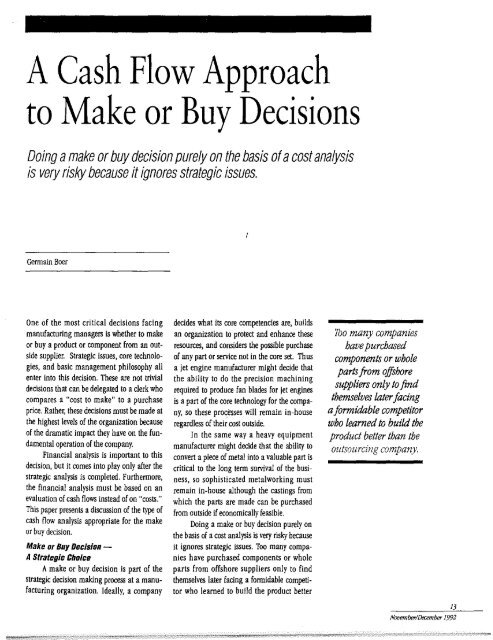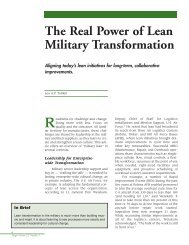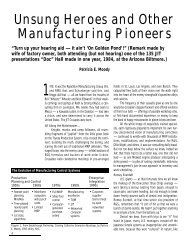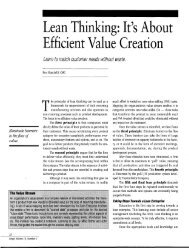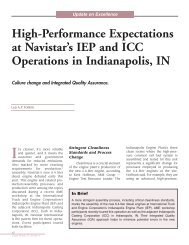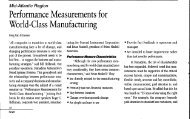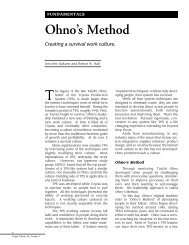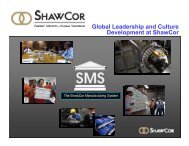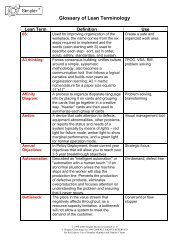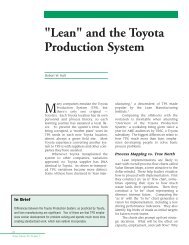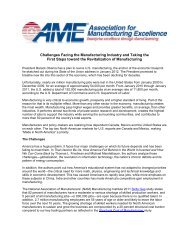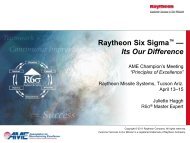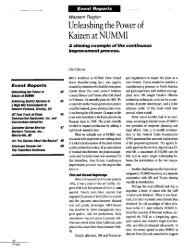ACash Flow Approach to Make or Buy Decisions - Association for ...
ACash Flow Approach to Make or Buy Decisions - Association for ...
ACash Flow Approach to Make or Buy Decisions - Association for ...
You also want an ePaper? Increase the reach of your titles
YUMPU automatically turns print PDFs into web optimized ePapers that Google loves.
<strong>ACash</strong> <strong>Flow</strong> <strong>Approach</strong><br />
<strong>to</strong> <strong>Make</strong> <strong>or</strong> <strong>Buy</strong> <strong>Decisions</strong><br />
Doing amake <strong>or</strong> buy decision purely on the basis ofacost analysis<br />
is very risky because it ign<strong>or</strong>es strategic issues.<br />
Germain Boer<br />
One of the most critical decisions facing<br />
manufacturing managers is whether <strong>to</strong> make<br />
<strong>or</strong> buy a product <strong>or</strong> component from an outside<br />
supplier. Strategic issues, c<strong>or</strong>e technologies,<br />
and basic management philosophy all<br />
enter in<strong>to</strong> this decision. These are not trivial<br />
decisions that can be delegated <strong>to</strong> a clerk who<br />
compares a "cost <strong>to</strong> make" <strong>to</strong> a purchase<br />
price. Rather, these decisions must be made at<br />
the highest levels of the <strong>or</strong>ganization because<br />
of the dramatic impact they have on the fundamental<br />
operation of the company.<br />
Financial analysis is imp<strong>or</strong>tant <strong>to</strong> this<br />
decision, but it comes in<strong>to</strong> play only after the<br />
strategic analysis is completed. Furtherm<strong>or</strong>e,<br />
the financial analysis must be based on an<br />
evaluation of cash flows instead of on "costs."<br />
This paper presents a discussion of the type of<br />
cash flow analysis appropriate f<strong>or</strong> the make<br />
<strong>or</strong> buy decision.<br />
<strong>Make</strong> <strong>or</strong> <strong>Buy</strong> Decision <br />
AStrategic Choice<br />
Amake <strong>or</strong> buy decision is part of the<br />
strategic decision making process at a manufacturing<br />
<strong>or</strong>ganization. Ideally, a company<br />
decides what its c<strong>or</strong>e competencies are, builds<br />
an <strong>or</strong>ganization <strong>to</strong> protect and enhance these<br />
resources, and considers the possible purchase<br />
of any part <strong>or</strong> service not in the c<strong>or</strong>e set. Th us<br />
a jet engine manufacturer might decide that<br />
the ability <strong>to</strong> do the precision machining<br />
required <strong>to</strong> produce fan blades f<strong>or</strong> jet engines<br />
is a part of the c<strong>or</strong>e technology f<strong>or</strong> the company,<br />
so these processes will remain in-house<br />
regardless oftheir cost outside.<br />
In the same way a heavy equipment<br />
manufacturer might decide that the ability <strong>to</strong><br />
convert a piece of metal in<strong>to</strong> a valuable part is<br />
critical <strong>to</strong> the long term survival of the business,<br />
so sophisticated metalw<strong>or</strong>king must<br />
remain in-house although the castings from<br />
which the parts are made can be purchased<br />
from outside if economically feasible.<br />
Doing a make <strong>or</strong> buy decision purely on<br />
the basis of a cost analysis is very risky because<br />
it ign<strong>or</strong>es strategic issues. Too many companies<br />
have purchased components <strong>or</strong> whole<br />
parts from offsh<strong>or</strong>e suppliers only <strong>to</strong> find<br />
themselves later facing a f<strong>or</strong>midable competi<strong>to</strong>r<br />
who learned <strong>to</strong> build the product better<br />
Too many companies<br />
havepurchased<br />
components <strong>or</strong> whole<br />
partsfrom offsh<strong>or</strong>e<br />
suppliers only <strong>to</strong> find<br />
themselves laterfacing<br />
af<strong>or</strong>midable competi<strong>to</strong>r<br />
who learned <strong>to</strong> build the<br />
product better than the<br />
outsourcing company.<br />
13<br />
November/December 1992
Cost Analysis of <strong>Make</strong> <strong>or</strong> <strong>Buy</strong> Decision<br />
Cost of Purchasing from Outside<br />
Monthly payments <strong>to</strong> supplier ($20 x20,000 units)<br />
Freight costs<br />
Handling cost<br />
(three material moves x$.65 cost per move x20,000 units)<br />
Total monthly cost of outside purchase<br />
Cost of Making Pari<br />
Material costs ($17 x20,000 units)<br />
Lab<strong>or</strong> costs (20 minutes x$.30 per minute x20,000 units)<br />
Stamping<br />
(three impressions x$.32 per impression x20,000 units)<br />
Welding (3 welds x$.45 per weld x20,000 units)<br />
Material handling (five moves x$.65 per move x20,000)<br />
Total monthly cost of making<br />
Figure 1.<br />
Cash <strong>Flow</strong> Analysis of <strong>Make</strong> <strong>or</strong> <strong>Buy</strong> Decision<br />
Cash Oulflow Eliminated by Not Purchasing<br />
Monthly payments <strong>to</strong> supplier ($20 x 20,000 units)<br />
Freight costs<br />
Total monthly cash outflows eliminated<br />
Cash Outflow Increase Caused by Making Pari<br />
Material costs ($17 x20,000 units)<br />
Welding (3 welds x$.05 per weld x20,000 units)<br />
Total monthly cash outflows put in place<br />
Figure 2.<br />
$400,000<br />
8,000<br />
39,000<br />
$447,000<br />
$340,000<br />
12,000<br />
19,200<br />
27,000<br />
65,000<br />
$463,200<br />
$400,000<br />
8,000<br />
$408,000<br />
$340,000<br />
3,000<br />
$343,000<br />
than the outsourcing company. Afirm must decide<br />
which technologies are the c<strong>or</strong>e of its business and<br />
which are peripheral, and only the peripheral parts and<br />
components are eligible f<strong>or</strong> purchase from the outside.<br />
The Economics of <strong>Make</strong> <strong>or</strong> <strong>Buy</strong><br />
Once <strong>to</strong>p executives have decided on the parts and<br />
components eligible f<strong>or</strong> purchase from outsiders, managers<br />
are ready <strong>to</strong> perf<strong>or</strong>m economic analyses on these<br />
eligible items. At first glance this looks easy. "Just compare<br />
the cost of making the part <strong>to</strong> the purchase price"<br />
sounds like good advice. However, there are some problems<br />
with this approach.<br />
Just What is A "Cost," Anyway<br />
Just consider the meaning of cost; "the cost of<br />
making a part" can have many different meanings<br />
depending on how one wants <strong>to</strong> use the cost. The "cost"<br />
of a part that accountants use <strong>to</strong> prepare financial statements<br />
f<strong>or</strong> s<strong>to</strong>ckholders is quite different from the "cost"<br />
<strong>to</strong> make one m<strong>or</strong>e unit after a machine is already set up<br />
<strong>to</strong> run 100 parts; and, this latter cost is different from<br />
the cost of making one m<strong>or</strong>e unit when only one unit<br />
will be run from the setup. Apart produced with idle<br />
resources has a radically different cost from the same<br />
part produced on bottleneck resources. We can go on<br />
defining additional unit costs f<strong>or</strong> several pages, and<br />
each cost will have a different value from the other.<br />
Consequently, if one is <strong>to</strong> use cost as the basis f<strong>or</strong> a<br />
make <strong>or</strong> buy decision, one must carefully define the precise<br />
rules needed <strong>to</strong> compute the cost <strong>to</strong> use in the analysis.<br />
Such a definition could be quite lengthy and<br />
would resemble a complex legal document.<br />
Cost avoidance<br />
Some managers argue f<strong>or</strong> using a "cost aVOidance"<br />
approach f<strong>or</strong> this decision; that is, compare the<br />
cost aVOided by purchasing <strong>to</strong> the cost of making. In<br />
addition <strong>to</strong> haVing the definitional problems just<br />
desCribed, the cost avoidance approach can sometimes<br />
lead <strong>to</strong> what I call the "don't buy a Mercedes" fallacy. I<br />
often tell my students they can save $50,000 per week<br />
just by s<strong>to</strong>pping at the iocal Mercedes dealer and deciding<br />
<strong>to</strong> avoid purchasing an au<strong>to</strong>mobile! So avoidable<br />
cost has problems <strong>to</strong>o, problems that can lead <strong>to</strong> unpredictable<br />
(and sometimes ludicrous) results.<br />
ABC<br />
Some auth<strong>or</strong>s advocate the use of actiVity-based<br />
costing <strong>to</strong> solve the cost measurement problems, but<br />
ABC simply converts these measurement problems in<strong>to</strong> a<br />
different f<strong>or</strong>m. It still has all the same problems as any<br />
other cost-based approach.<br />
The Cash <strong>Flow</strong> <strong>Approach</strong><br />
To avoid thiS complexity and possible confusion,<br />
managers can use a cash flow approach. With this<br />
approach a manager compares the periodic cash outflow<br />
eliminated by dropping the purchase <strong>or</strong> manufacture<br />
of a product <strong>to</strong> the cash outflow put in its place.<br />
Cash flow analysis requires managers <strong>to</strong> consider all the<br />
14<br />
Target
elevant economic issues, but it avoids the ambiguities<br />
of a cost-based approach.<br />
Defining which cash flows will increase <strong>or</strong><br />
decrease and when they will change is much easier than<br />
trying <strong>to</strong> decide ''what it really costs <strong>to</strong> make" a circuit<br />
board, f<strong>or</strong> example. cash flow analysis also readily<br />
handles one-time purchases of special <strong>to</strong>oling, new<br />
equipment, <strong>or</strong> rearrangement of plant space. It<br />
includes everything that a cost analysis includes, but it<br />
does it in a much m<strong>or</strong>e manageable fashion.<br />
Cash <strong>Flow</strong> and Cost Compared<br />
Consider the following comparison of a cost-based<br />
approach with cash flow analysis. Air Coole has developed<br />
a flow line that makes air conditioners. The line<br />
produces 90 different variations on four products, but it<br />
produces only six hours per day because of low demand<br />
f<strong>or</strong> the products. Air Coole managers deliberately built<br />
the line with excess capacity because they expect output<br />
<strong>to</strong> increase over the next few years, and they plan <strong>to</strong> use<br />
the idle time they have now <strong>to</strong> train w<strong>or</strong>kers in<br />
advanced manufacturing techniques so their productivity<br />
will increase as product demand grows.<br />
The plant manager is considering using some of<br />
this idle time <strong>to</strong> make apart now purchased f<strong>or</strong> $20. The<br />
line has stamping machines, robot welders, and assembly<br />
<strong>to</strong>ols that could easily be used <strong>to</strong> make the part.<br />
Using a cost-based analysis the plant accountant<br />
prepares the schedule found in Figure 1.<br />
The accountant has carefully assigned costs <strong>to</strong> the<br />
product f<strong>or</strong> every resource consumed in its production,<br />
and the analysis shows it will cost the company<br />
$463,200 per month <strong>to</strong> make the product as compared<br />
<strong>to</strong> only $447,000 <strong>to</strong> purchase it from the supplier. However,<br />
the cash flow analysis in the schedule in Figure 2<br />
tells a different s<strong>to</strong>ry.<br />
The cost analysis includes lab<strong>or</strong>, stamping, and<br />
material handling costs, but the cash flow analysis indicates<br />
no change in cash flows related <strong>to</strong> these activities<br />
because the company still needs the same number of<br />
people, the same stamping machines, and the same<br />
material handling capability even if the outside purchase<br />
s<strong>to</strong>ps. The only increase in cash outflows occurs<br />
in welding materials and the purchased materials.<br />
None of the other cash outflows associated with the<br />
manufacturing line change because the company<br />
incurs these outflows whether <strong>or</strong> not it purchases the<br />
part from the outside.<br />
Does this analysis mean Air Coole should make<br />
the part instead of buying it Not necessarily. If company<br />
managers want <strong>to</strong> continue training w<strong>or</strong>kers during<br />
the idle time on the line each day, they will decide<br />
not <strong>to</strong> purchase outside even though there might be a<br />
sh<strong>or</strong>t run cash advantage.<br />
However, if managers decide <strong>to</strong> use this idle<br />
capacity <strong>to</strong> make the part because it fits the company<br />
strategy, then the economic analysis shows the company<br />
should bring the part in house. In other w<strong>or</strong>ds, the economic<br />
analysis complements the strategic analysis<br />
managers make <strong>to</strong> decide whether <strong>to</strong> make <strong>or</strong> buy a<br />
part.<br />
Conclusion<br />
This example demonstrates how a cost-based<br />
analysis of a make <strong>or</strong> buy decision can give misleading<br />
results. However, even m<strong>or</strong>e imp<strong>or</strong>tant, one should recognize<br />
that no cost analysis, regardless of how the costs<br />
are computed, can provide managers with all the inf<strong>or</strong>mation<br />
they need f<strong>or</strong> make <strong>or</strong> buy decisions. Company<br />
strategy is the final dicta<strong>to</strong>r of make <strong>or</strong> buy decisions.<br />
Ign<strong>or</strong>ing company strategy in this decision is much<br />
w<strong>or</strong>se than using the wrong economic analysis.<br />
Germain Boer ;s profess<strong>or</strong> of management at the Owen<br />
Graduate School of Management of Vanderbilt Univerisly<br />
where he teaches and researches management accounting<br />
and computer applications 0/ accounting proceses. He is a<br />
CPA, and consults with manufacturing firms on<br />
perf<strong>or</strong>mance measurement. He is the auth<strong>or</strong> of Direct Cost<br />
and Contribution Accounting, Wiley In/erscience, 1974, and<br />
co-au/b<strong>or</strong> a/Cost Accounting. Dame Publications, 199/.<br />
Il:> 1992AME<br />
F<strong>or</strong> infonnation on reprinlS, contact:<br />
<strong>Association</strong> f<strong>or</strong> Manufacturing Excellence<br />
380 West Palatine Road<br />
Wheelin~ IL 60090<br />
70lIl520-3282<br />
15<br />
November/JJecmzber 1992


